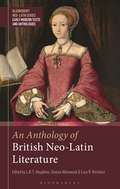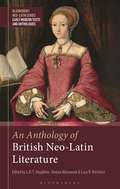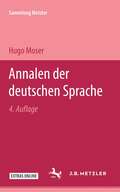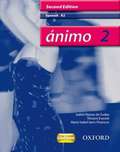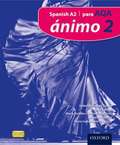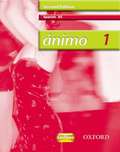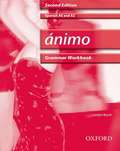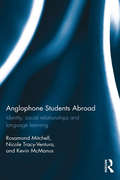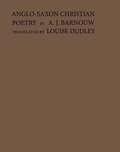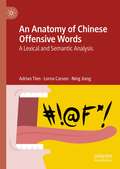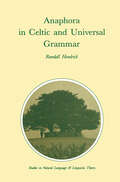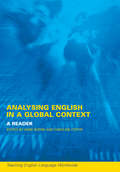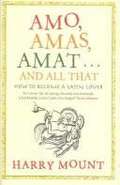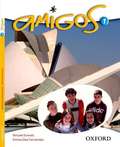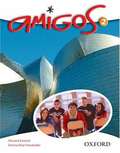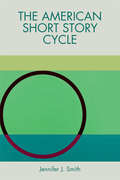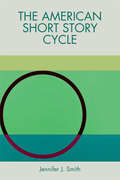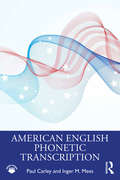- Table View
- List View
An Anthology of British Neo-Latin Literature (Bloomsbury Neo-Latin Series: Early Modern Texts and Anthologies)
by Gesine Manuwald L. B. Houghton Lucy R. NicholasThis volume offers a wide range of sample passages from literature written in Latin in the British Isles during the period from about 1500 to 1800. It includes a general introduction to and bibliography to the Latin literature of these centuries, as well as Latin texts with English translations, introductions and notes. These texts present a rich panorama of the different literary genres, styles and themes flourishing at the time, illustrating the role of Latin texts in the development of literary genres, the diversity of authors writing in Latin in early modern Britain, and the importance of Latin in contemporary political, religious and scientific debates. The collection, which includes both texts by well-known authors (such as John Milton, Thomas More and George Buchanan) and previously unpublished items, can be used as a point of entry for students at school and university level, but will also be of interest to specialists in a number of academic disciplines.
An Anthology of British Neo-Latin Literature (Bloomsbury Neo-Latin Series: Early Modern Texts and Anthologies)
by Gesine Manuwald L. B. Houghton Lucy R. NicholasThis volume offers a wide range of sample passages from literature written in Latin in the British Isles during the period from about 1500 to 1800. It includes a general introduction to and bibliography to the Latin literature of these centuries, as well as Latin texts with English translations, introductions and notes. These texts present a rich panorama of the different literary genres, styles and themes flourishing at the time, illustrating the role of Latin texts in the development of literary genres, the diversity of authors writing in Latin in early modern Britain, and the importance of Latin in contemporary political, religious and scientific debates. The collection, which includes both texts by well-known authors (such as John Milton, Thomas More and George Buchanan) and previously unpublished items, can be used as a point of entry for students at school and university level, but will also be of interest to specialists in a number of academic disciplines.
Annalen der deutschen Sprache von den Anfängen bis zur Gegenwart: Sammlung Metzler, 5 (Sammlung Metzler)
by Hugo MoserAnimo 2 Spanish A2: Student Book (2nd edition) (PDF)
by Alonso de Sudea, Isabel'Animo' provides a smooth transition from GCSE to A Level, with a diagnostic test to determine students' abilities, clear grammatical explanations and full practice and language learning strategies.
Animo 2: Spanish A2 Para AQA (PDF)
by Vincent Everett Isern Vivancos, Maria Isabel Alonso De SudeaThese editions are a complete match to the AQA specification, giving you everything you need for AQA A Level Spanish. It offers comprehensive grammar and skills support, helping students understand and manipulate new language.
Animo 1: Student Book (2nd edition) (PDF)
by Vivancos, Maria Isabel Isern Vincent Everett Alonso de Sudea, Isabel'Animo' provides a smooth transition from GCSE to A Level, with a diagnostic test to determine students' abilities, clear grammatical explanations and full practice and language learning strategies.
Animo: Spanish AS and A2 (PDF)
by Carolyn Burch'Animo' provides a smooth transition from GCSE to A Level, with a diagnostic test to determine students' abilities, clear grammatical explanations and full practice and language learning strategies.
Anglophone Students Abroad: Identity, Social Relationships, and Language Learning
by Rosamond Mitchell Kevin McManus Nicole Tracy-VenturaAnglophone students abroad: Identity, social relationships and language learning presents the findings of a major study of British students of French and Spanish undertaking residence abroad. The new dataset presented here provides both quantitative and qualitative information on language learning, social networking and integration and identity development during residence abroad. The book tracks in detail the language development of participants and relates this systematically to individual participants’ social and linguistic experiences and evolving relationship. It shows that language learning is increasingly dependent on students’ own agency and skill and the negotiation of identity in multilingual and lingua franca environments.
Anglophone Students Abroad: Identity, Social Relationships, and Language Learning
by Rosamond Mitchell Kevin McManus Nicole Tracy-VenturaAnglophone students abroad: Identity, social relationships and language learning presents the findings of a major study of British students of French and Spanish undertaking residence abroad. The new dataset presented here provides both quantitative and qualitative information on language learning, social networking and integration and identity development during residence abroad. The book tracks in detail the language development of participants and relates this systematically to individual participants’ social and linguistic experiences and evolving relationship. It shows that language learning is increasingly dependent on students’ own agency and skill and the negotiation of identity in multilingual and lingua franca environments.
The Ancient Sea: The Utopian and Catastrophic in Classical Narratives and their Reception
In the ancient Mediterranean world, the sea was an essential domain for trade, cultural exchange, communication, exploration, and colonisation. In tandem with the lived reality of this maritime space, a parallel experience of the sea emerged in narrative representations from ancient Greece and Rome, of the sea as a cultural imaginary. This imaginary seems often to oscillate between two extremes: the utopian and the catastrophic; such representations can be found in narratives from ancient history, philosophy, society, and literature, as well as in their post-classical receptions. Utopia can be found in some imaginary island paradise far away and across the distant sea; the sea can hold an unknown, mysterious, divine wealth below its surface; and the sea itself as a powerful watery body can hold a liberating potential. The utopian quality of the sea and seafaring can become a powerful metaphor for articulating political notions of the ideal state or for expressing an individual’s sense of hope and subjectivity. Yet the catastrophic sea balances any perfective imaginings: the sea threatens coastal inhabitants with floods, tsunamis, and earthquakes and sailors with storms and the accompanying monsters. From symbolic perspectives, the catastrophic sea represents violence, instability, the savage, and even cosmological chaos. The twelve papers in this volume explore the themes of utopia and catastrophe in the liminal environment of the sea, through the lens of history, philosophy, literature and classical reception.Contributors: Manuel Álvarez-Martí-Aguilar, Vilius Bartninkas, Aaron L. Beek, Ross Clare, Gabriele Cornelli, Isaia Crosson, Ryan Denson, Rhiannon Easterbrook, Emilia Mataix Ferrándiz, Georgia L. Irby, Simona Martorana, Guy Middleton, Hamish Williams.
Ancient Greek I: A 21st Century Approach
by Philip S. PeekIn this elementary textbook, Philip S. Peek draws on his twenty-five years of teaching experience to present the ancient Greek language in an imaginative and accessible way that promotes creativity, deep learning, and diversity. The course is built on three pillars: memory, analysis, and logic. Readers memorize the top 250 most frequently occurring ancient Greek words, the essential word endings, the eight parts of speech, and the grammatical concepts they will most frequently encounter when reading authentic ancient texts. Analysis and logic exercises enable the translation and parsing of genuine ancient Greek sentences, with compelling reading selections in English and in Greek offering starting points for contemplation, debate, and reflection. A series of embedded Learning Tips help teachers and students to think in practical and imaginative ways about how they learn. This combination of memory-based learning and concept- and skill-based learning gradually builds the confidence of the reader, teaching them how to learn by guiding them from a familiarity with the basics to proficiency in reading this beautiful language. Ancient Greek I: A 21st-Century Approach is written for high-school and university students, but is an instructive and rewarding text for anyone who wishes to learn ancient Greek.
An Anatomy of Chinese Offensive Words: A Lexical and Semantic Analysis
by Lorna Carson Ning Jiang Adrian TienThis book offers a precise and rigorous analysis of the meanings of offensive words in Chinese. Adopting a semantic and cultural approach, the authors demonstrate how offensive words can and should be systematically researched, documented and accounted for as a valid aspect of any language. The book will be of interest to academics, practitioners and students of sociolinguistics, language and culture, linguistic taboo, Chinese studies and Chinese linguistics.
Anaphora in Celtic and Universal Grammar (Studies in Natural Language and Linguistic Theory #14)
by R. HendrickThis book is based in large part on fieldwork that I conducted in Brittany and Wales in 1983 and 1985. I am thankful for a Fulbright Award for Research in Western Europe and a Faculty Development Award from the University of North Carolina that funded that fieldwork. lowe a less tangible, but no less real, debt to Steve Anderson, G. M. Awbery, Steve Harlow and Jim McCloskey whose work initially sparked my interest, and led me to undertake this project. I want to thank Joe Emonds and Alec Marantz who read portions of Chapter 3 and 5. I am particularly grateful though to Kathleen Flanagan, Frank Heny and two anonymous referees who read a dyslexic and schizophrenic manuscript, providing me with criticisms that improved this final version considerably. The Welsh nationalist community in Aberstwyth and its Breton coun terpart in Quimper helped make the time I spent in Wales and Brittany productive. I am indebted to Thomas Davies, Partick Favreau, Lukian Kergoat, Sue Rhys, John Williams and Beatrice among others for sharing their knowledge of their languages with me. Catrin Davies and Martial Menard were especially patient and helpful. Without their assistance this work would have been infinitely poorer. I am hopeful that this book will help stimulate more interest in the Celtic languages and culture, and assist, even in a small way, those in Wales and Brittany who struggle to keep their language and culture strong.
Analysing English In A Global Context (PDF)
by Anne Burns Caroline CoffinDevised in collaboration with the Open University and Macquarie University, Australia, this book is specifically designed for the postgraduate student market, as well as for teachers of English as a second or foreign language throughout the world. It includes specially commissioned pieces as well as classic texts and provides a global perspective on the changing uses and forms of English and its impact on language teaching contexts.
Analysing English In A Global Context
by Anne Burns Caroline CoffinDevised in collaboration with the Open University and Macquarie University, Australia, this book is specifically designed for the postgraduate student market, as well as for teachers of English as a second or foreign language throughout the world. It includes specially commissioned pieces as well as classic texts and provides a global perspective on the changing uses and forms of English and its impact on language teaching contexts.
Análisis de la Conversación: fundamentos, metodología y alcances
by Chase Wesley Raymond Luis Manuel OlguínAnálisis de la Conversación: fundamentos, metodología y alcances ofrece la primera introducción comprehensiva al Análisis de la Conversación (AC) en español y con datos conversacionales disponibles en línea. El libro está organizado en nueve capítulos. En los capítulos iniciales, se presenta el AC como una disciplina y método analítico para el estudio del habla y otras formas de conducta humana en la interacción social, se hace un breve recuento histórico del desarrollo de la perspectiva analítico-conversacional y se introduce a los lectores al sistema de transcripción usado en el AC. Los capítulos siguientes están dedicados a explorar cuatro dominios claves en la organización de la conversación espontánea: la toma de turnos, las secuencias de acciones, la preferencia y la enmienda, destacando la importancia de prácticas del diseño de turno en cada dominio. Seguidamente, se discute la conexión entre organizaciones y prácticas del habla en interacción y contextos sociales e identidades de los participantes en conversación. El libro concluye ofreciendo una serie de sugerencias para la investigación analítico-conversacional en español y señalando su relevancia para la indagación de la interacción en contextos legales, políticos, médicos, tecnológicos, entre otros. Cada capítulo incluye ejemplos tomados de conversaciones auténticas en distintas variedades de español, cuyos audios pueden ser consultados directamente en línea. Con el fin de revisar y profundizar lo aprendido, cada capítulo ofrece un apartado final con preguntas, actividades y lecturas adicionales. Como apéndices al libro, se ofrecen, además, un glosario de términos bidireccional español–inglés y un sumario con las convenciones de transcripción más usadas. Escrito enteramente en español, el libro ofrece una introducción actual, comprehensiva y amigable al AC y sus aplicaciones por lo que constituye una fuente de referencia ideal para estudiantes, instructores e investigadores en lingüística (hispánica), sociología y comunicaciones. Análisis de la Conversación provides the first comprehensive, Spanish-language introduction to the field of Conversation Analysis (CA), utilizing conversational data that is publicly available online. The book is organized in nine chapters. The opening chapters introduce Conversation Analysis as a unique theory and method to study language and other forms of conduct in social interaction. Readers are presented with a history of the development of this framework for analyzing interaction and introduced to the transcription system used in CA. The following chapters explore four key domains of organization within spontaneous conversation—turn-taking, preference, sequence, and repair—highlighting the importance of turn design practices in each. The authors then review the connection of these organizations and practices to social contexts and participant identities, and they conclude by suggesting a range of avenues for future research on Spanish conversation, including its relevance in specific legal, political, medical, and technological settings. Each chapter includes a variety of examples from authentic Spanish conversation, which readers can consult directly online. Each chapter is additionally accompanied by a set of questions and activities that allow readers to check and reinforce their understanding, as well as lists of additional readings for readers interested in more specific topics. Glossaries of technical vocabulary—both Spanish-English and English-Spanish—are included as appendices, along with a summary of transcription system notation. Written entirely in Spanish, this book presents a thorough and engaging introduction to Conversation Analysis and its applications. It is ideal for students, instructors, and researchers in Hispanic Studies, (Spanish) Linguistics, Sociology, and Communication Studies.
Análisis de la Conversación: fundamentos, metodología y alcances
by Chase Wesley Raymond Luis Manuel OlguínAnálisis de la Conversación: fundamentos, metodología y alcances ofrece la primera introducción comprehensiva al Análisis de la Conversación (AC) en español y con datos conversacionales disponibles en línea. El libro está organizado en nueve capítulos. En los capítulos iniciales, se presenta el AC como una disciplina y método analítico para el estudio del habla y otras formas de conducta humana en la interacción social, se hace un breve recuento histórico del desarrollo de la perspectiva analítico-conversacional y se introduce a los lectores al sistema de transcripción usado en el AC. Los capítulos siguientes están dedicados a explorar cuatro dominios claves en la organización de la conversación espontánea: la toma de turnos, las secuencias de acciones, la preferencia y la enmienda, destacando la importancia de prácticas del diseño de turno en cada dominio. Seguidamente, se discute la conexión entre organizaciones y prácticas del habla en interacción y contextos sociales e identidades de los participantes en conversación. El libro concluye ofreciendo una serie de sugerencias para la investigación analítico-conversacional en español y señalando su relevancia para la indagación de la interacción en contextos legales, políticos, médicos, tecnológicos, entre otros. Cada capítulo incluye ejemplos tomados de conversaciones auténticas en distintas variedades de español, cuyos audios pueden ser consultados directamente en línea. Con el fin de revisar y profundizar lo aprendido, cada capítulo ofrece un apartado final con preguntas, actividades y lecturas adicionales. Como apéndices al libro, se ofrecen, además, un glosario de términos bidireccional español–inglés y un sumario con las convenciones de transcripción más usadas. Escrito enteramente en español, el libro ofrece una introducción actual, comprehensiva y amigable al AC y sus aplicaciones por lo que constituye una fuente de referencia ideal para estudiantes, instructores e investigadores en lingüística (hispánica), sociología y comunicaciones. Análisis de la Conversación provides the first comprehensive, Spanish-language introduction to the field of Conversation Analysis (CA), utilizing conversational data that is publicly available online. The book is organized in nine chapters. The opening chapters introduce Conversation Analysis as a unique theory and method to study language and other forms of conduct in social interaction. Readers are presented with a history of the development of this framework for analyzing interaction and introduced to the transcription system used in CA. The following chapters explore four key domains of organization within spontaneous conversation—turn-taking, preference, sequence, and repair—highlighting the importance of turn design practices in each. The authors then review the connection of these organizations and practices to social contexts and participant identities, and they conclude by suggesting a range of avenues for future research on Spanish conversation, including its relevance in specific legal, political, medical, and technological settings. Each chapter includes a variety of examples from authentic Spanish conversation, which readers can consult directly online. Each chapter is additionally accompanied by a set of questions and activities that allow readers to check and reinforce their understanding, as well as lists of additional readings for readers interested in more specific topics. Glossaries of technical vocabulary—both Spanish-English and English-Spanish—are included as appendices, along with a summary of transcription system notation. Written entirely in Spanish, this book presents a thorough and engaging introduction to Conversation Analysis and its applications. It is ideal for students, instructors, and researchers in Hispanic Studies, (Spanish) Linguistics, Sociology, and Communication Studies.
Amo, Amas, Amat - And All That: Put A Little Latin In Your Life (PDF)
by Harry MountUncover the hidden charms of Latin
Amigos (PDF)
by Vincent Everett Emma Diaz FernandezAmigos 1 is the first part of a new contemporary Key Stage 3 Spanish course, designed specifically for Year 7 starters. Amigos is a 3-part Spanish course, so there if one part per year at Key Stage 3, making planning and course delivery much smoother. Parts 1-3 are single-tier in format (withdifferentiation being supplied in the Higher and Lower Workbooks, differentiated Copymasters, extension and support section and differentiated reading section at the back of the Students' Book). This fully-integrated course includes the following components: Students' Book, Workbook (Higher), Workbook (Lower), Copymasters, Teacher's Book, Audio CDs, ICT package (Students' and Teacher's), En claro (low level) support pack, Coursemaster. The Amigos Students' Book is fully Frameworked: it contains starters and plenaries on every spread and grammar and language strategies are explained in clear, concise language. Students are encouraged to discuss and reflect upon what they've learnt. Differentiated assessment is provided through thechecklists with graded activities that are at the end of each unit in the Students' Book and the Copymasters. These can be used for self-assessment. There is also plenty of opportunity for independent study in the support and extension sections, reading section and grammar activities at the end ofthe spread, which are ideal for coverwork and homework. The fifth double-page spread of each unit provides extended reading material featuring an aspect of Spanish or Latin American life connect with the unit topics, and this is also very useful for independent study.
Amigos 2: Student Book (PDF)
by Vincent Everett Emma Diaz FernandezAmigos 2 is the second part of a new contemporary Key Stage 3 Spanish course, designed specifically for Year 7 starters. Amigos is a 3-part Spanish course, so there if one part per year at Key Stage 3, making planning and course delivery much smoother. Parts 1-3 are single-tier in format (withdifferentiation being supplied in the Higher and Lower Workbooks, differentiated Copymasters, extension and support section and differentiated reading section at the back of the Students' Book). This fully-integrated course includes the following components: Students' Book, Workbook (Higher), Workbook (Lower), Copymasters, Teacher's Book, Audio CDs, ICT package (Students' and Teacher's), En claro (low level) support pack, Coursemaster. The Amigos Students' Book is fully Frameworked: it contains starters and plenaries on every spread and grammar and language strategies are explained in clear, concise language. Students are encouraged to discuss and reflect upon what they've learnt. Differentiated assessment is provided through thechecklists with graded activities that are at the end of each unit in the Students' Book and the Copymasters. These can be used for self-assessment. There is also plenty of opportunity for independent study in the support and extension sections, reading section and grammar activities at the end ofthe spread, which are ideal for coverwork and homework. The fifth double-page spread of each unit provides extended reading material featuring an aspect of Spanish or Latin American life connect with the unit topics, and this is also very useful for independent study.
Amici: AQA GCSE Study Guide (Amici Ser.)
by Carole Shepherd Derek AustA self-study revision booklet and audio CD. Ideal to help GCSE/Standard Grade students of Italian get to grips with the language, and reach the best grades at their exams.
The American Short Story Cycle
by Jennifer J. SmithExplores the contradictory position of Arabic being both the official language and marginalized in Israel
The American Short Story Cycle
by Jennifer J. SmithA critical overview of the USA efforts to prevent Iran from building nuclear weapons, from the 1970s to 2015
American English Phonetic Transcription
by Paul Carley Inger M. MeesAmerican English Phonetic Transcription provides an accessible introduction to phonemic, phonetic, and intonational transcription with a focus on American English. Featuring exercises, revision tasks, and recordings to help students gain hands-on practice, the book takes a learning-by-doing approach and ensures students gain practice using each new symbol or concept introduced before moving on to the next. Consisting of three parts, the book covers: transcribing individual words, including consonants, vowels, primary stress, secondary stress, syllabic consonants, and inflections; transcribing phrases and sentences, including weak forms, elision, and assimilation; transcribing intonation, including the structure of English intonation and recognizing pitch patterns. Ideally suited as a standalone workbook or for use alongside British English Phonetic Transcription, American English Phonetic Transcription is key reading for undergraduate students of linguistics as well as anyone teaching or learning English as a foreign language.
